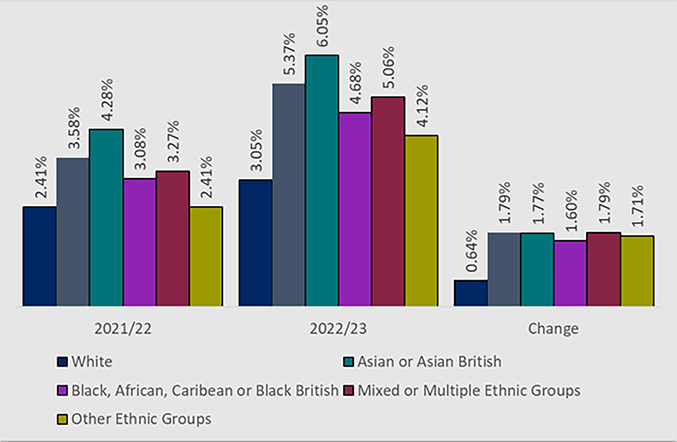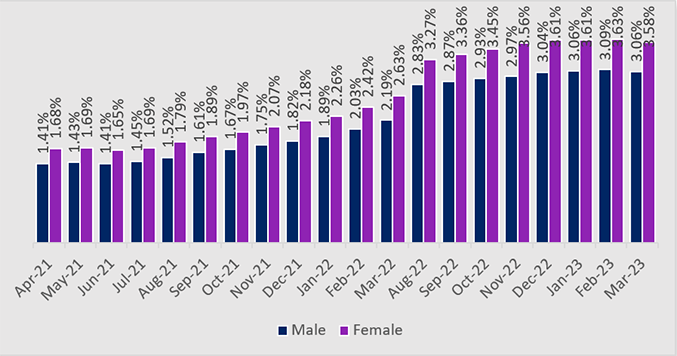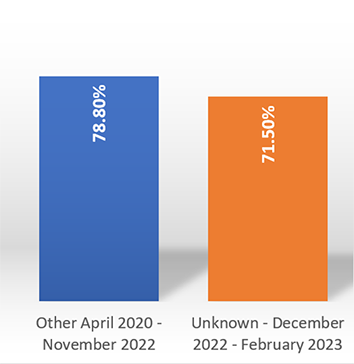The storm of police officer resignations: Part 2
5 September 2023
Polfed News
There is little doubt that efforts to retain officers should not be restricted to those early in their career. Work to arrest attrition rates needs to address a variety of themes across different cohorts in policing with the aim of reinstating the profession as a long-term career of choice.
The NPCC’s refreshed analysis of the July 2022 study of attrition trends reveals that the difference in resignation rates between white officers and ethnic minority groups has grown disproportionally to overall resignation rates but provides no reasoning for this. The analysis suggests that a higher uptake of ethnic minority officers naturally sees a spike in resignations of the same cohort, but without recording and analysis of data, chief officers can only speculate as to why the spike may exceed that of white officers.

Source: NPCC
Equally, there is a higher incidence of resignation amongst female officers over male officers, though new-in-service resignations are lower than their male colleagues; the shortfall is more than made up for by those in mid-service where the rate exceeds male officer resignations, resulting in overall higher resignation figures for female officers.

Source: NPCC
A focus on work-life balance/workforce flexibility, organisational culture, promotion, and addressing specific barriers and challenges experienced by both ethnic minority officers and female officers may go a long way to build a more supportive and sustainable workforce, as well as maintain the gains made in representation during the Uplift Programme. But again, for there to be progress in these areas, data is key, so understanding the motivations for leaving at any stage must be improved.
As demonstrated by the graphs above, a higher proportion of female officers leave between 11 and 15 years’ service, and 16 and 20 years’ service, suggesting that the challenges posed by family life and maintaining a healthy work-life balance may have been some of the drivers. However, without adequate data generated from exit interviews lessons cannot be learnt.
The NPCC’s analysis clearly implies that without improving the recording of leavers’ data, forces will continue to struggle to understand attrition trends and formulate ways to address them. The National Leavers Framework (NLF) was introduced in December 2022 and is designed to improve the data collection on reasons for officers leaving police forces in England and Wales.
The NLF aims to develop a standardised and consistent data set across all 43 forces that can help streamline reporting of attrition, data which can identify workforce trends and extrapolate insights accordingly. The NFL also aims to improve employee engagement during the exit process and thus inform local and national retention strategies through better organisational listening.
For this to work and be effective it must have a 100 per cent uptake amongst all forces in England and Wales, but unfortunately, this is not the case. Only by being learning-driven and people-focused equally across all forces can a strategy of early interventions and inclusivity be formulated and implemented to really impact leaver numbers. This encouragement of forces to invest in organisational listening and dignified exits will improve employee engagement and leaver insights, but for this, chief officers of all the 43 forces need to actively support and understand the NLF.
Since the NLF’s launch and increased adoption by many of the forces, there has been an improvement of a specified reason for resignation - Unknown, with overall ‘unknowns’ coming down by 28 per cent to 59 per cent in May 2023 (as demonstrated in, The storm of police officer resignations: Part-1).
The NPCC’s analysis concludes that the NLF’s improved data will allow for much richer analysis, and understanding across different cohorts such as sex, ethnicity, age, length of service and rank. This can then be overlaid on to reasons for leaving to build richer picture of workforce trends. This should also create “opportunities to meaningfully target interventions to improve employee experience and drive officer retention”, the NPCC’s analysis observes.
The improvement in data collection brought by the introduction of the NLF since December 2022 is evident from the below graph:

Source: NPCC
It is time chief officers learn from the NPCC’s analysis and acknowledge that the NFL is vital to improving organisational listening across all forces and insights into resignations. It can help coordinate a national strategy to arrest attrition rates based on learned insights, and it can allow for a much closer monitoring of potential patterns in attrition. Crucially, it can also help identify patterns that can be addressed in recruitment, onboarding, and retention.
If all chief officers follow the NLF, it will be possible to use data insights to focus on creating employment models that are fit-for-purpose in policing, provide career paths and opportunities that meet officers’ ambitions and ensure learnings from all cohorts are gained during exit interviews leading to increased retention and reduced recruitment costs.


















